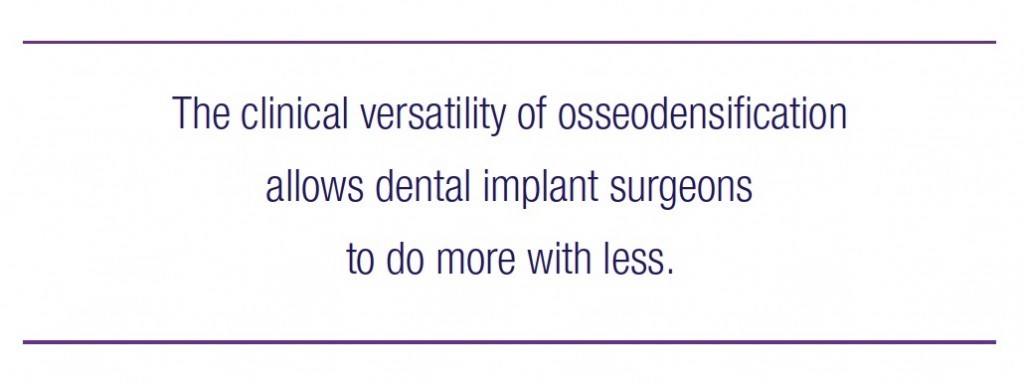
The Densah® Bur technology is based on a novel biomechanical bone preparation technique called “osseodensification.” Unlike traditional dental drilling techniques, osseodensification does not excavate bone tissue. Rather, bone tissue is simultaneously compacted and autografted in an outwardly expanding direction from the osteotomy, somewhat akin to a traditional hammered osteotome but without the trauma and other limitations.
[userloggedin]
When a Densah® Bur is rotated at high speed in a reversed, non-cutting direction with steady external irrigation, a strong and dense layer of bone tissue is formed along the walls and base of the osteotomy. Dense compacted bone tissue produces stronger purchase for your favorite dental implant and may facilitate faster healing.
Clinical advantages of osseodensification
Some surgeons feel that osseodensification eliminates the guessing game of implant primary stability, which is helping them in their All-on-4 cases. Others have shared with us their positive results when using osseodensification to facilitate alveolar ridge expansion in both jaws.
They have told us that osseodensification is reducing the minimum amount of bone needed to predictably place an implant. Many surgeons have used the Densah® Bur successfully in sinus autografting procedures; we have included the steps for this procedure below.

 Maxillary sinus autografting
Maxillary sinus autografting
- Flap the soft tissue using the instruments and technique normally used.
- In cases where posterior residual alveolar ridge height is 7.0 mm, and additional vertical depth is desired, drill to the depth determined within an approximate safety zone of 1.0 mm from the sinus floor using a pilot drill (clockwise drill speed 800-1500 rpm with copious irrigation). Confirm pilot drill position with a radiograph.
- Depending upon the implant type and diameter selected for the site, begin with the narrowest Densah® Bur. Change the drill motor to reverse-Densifying Mode (counterclockwise drill speed 800-1500 rpm with copious irrigation). Begin running the bur into the osteotomy. When feeling the haptic feedback of the bur reaching the dense sinus floor, modulate pressure with a gentle pumping motion to advance past the sinus floor. Maximum advancement past the sinus floor at this stage must not exceed 1.0 mm. Confirm the first Densah® Bur vertical position with a radiograph.
- As the next Densah® Bur advances in the osteotomy, bone will be pushed toward the apical end and will begin to gently lift the membrane and autograft compacted bone. Use the sequential Densah® Burs in Densifying Mode (counterclockwise drill speed 800-1500 rpm with copious irrigation) with gentle pumping motion to achieve additional vertical depth and maximum membrane lift of 3.0 mm (in 1.0 mm increments) and reach final desired width for implant placement. In cases where residual alveolar ridge height is less than 7.0 mm, and additional lift of the membrane (more than 3.0 mm) is desired, a bone graft material can be placed into the final width osteotomy. Use the last Densah® Bur in Densifying Mode (counterclockwise drill speed 200-600 rpm with slow irrigation) with gentle pumping motion. The Densah® Bur must only facilitate the graft material compaction to lift the sinus membrane further, and not advance beyond the sinus floor. Implant insertion will then drive the graft material into the final desired depth.
- Place the implant into the osteotomy. If using the drill motor to tap the implant into place, the unit may stop when reaching the placement torque maximum. Finish placing the implant to depth with a torque indicating ratchet wrench.
Click link to view video:
https://versah.com/clinical/
This information was provided by Versah®.
[/userloggedin]
[userloggedout][/userloggedout]
Stay Relevant With Implant Practice US
Join our email list for CE courses and webinars, articles and mores



